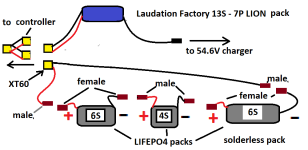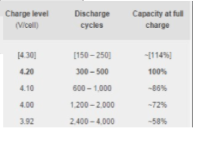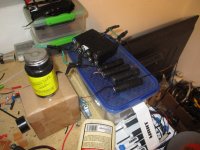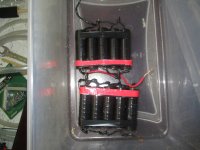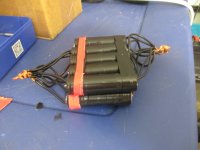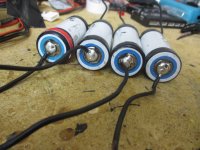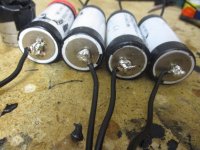latecurtis
100 MW
I recently built my first LIFEPO4 packs. I ordered 80 K2 energy cells from battery hookup. The first 6S pack was solderless but took up a lot more space than desired so I got a new 80 watt iron and some large tips and soldered a second 6S pack and a 4S pack.
I thought LIFEPO4 charged to 3.7V per cell but they settled at 3.3V per cell.
Standing voltage is 53V. - 16S.
The problem is I only used 16 gauge wire. I can only draw 600 watts from the pack safely but need about 1,200W.
About a year ago I bought a 13S - 7P pack rated at 20 Ah and 1,000W. I need about 200 watts more as am running a 26" - 1,000W direct drive hub motor. The top speed should be like 30 mph or at least 28 mph but not even close and it is about useless up hills with the 13S lion pack.
1,000W / 48V = 20.8 * 53 = 1,104 watts.
Basically I do not want to take the LIFEPO4s apart and re solder 12 gauge wire. I also built three packs each with a balance plug to charge with my 6S LiPo chargers. The packs are illustrated below.
After extensive searching I see people have paralleled up LiPo to lithium ion and both of those to SLAs but I have NOT seen LIFEPO4 in parallel with anything except LTOs I think.
Since the LIFEPO4s are brand new and never ran them and the Lithium ion pack is > 100 cycles all batteries are close in age and use as well as standing voltage.
Even the capacity is within 1Ah.
The 13S - 7P - Lion pack is rated at 20 AH and the 16S LIFEPO4 at 19 AH. 3.8 Ah * 5 cells in parallel = 19AH. I was thinking that I would not need to charge everything separate if all in parallel as the 13S - Lion pack has a charge port and I have 3 balancers if I need to balance one of the LIFEPO4 packs.
Here is the diagram.
Will it work ???????
Please let me know.
Thanks.
LC. out.
I thought LIFEPO4 charged to 3.7V per cell but they settled at 3.3V per cell.
Standing voltage is 53V. - 16S.
The problem is I only used 16 gauge wire. I can only draw 600 watts from the pack safely but need about 1,200W.
About a year ago I bought a 13S - 7P pack rated at 20 Ah and 1,000W. I need about 200 watts more as am running a 26" - 1,000W direct drive hub motor. The top speed should be like 30 mph or at least 28 mph but not even close and it is about useless up hills with the 13S lion pack.
1,000W / 48V = 20.8 * 53 = 1,104 watts.
Basically I do not want to take the LIFEPO4s apart and re solder 12 gauge wire. I also built three packs each with a balance plug to charge with my 6S LiPo chargers. The packs are illustrated below.
After extensive searching I see people have paralleled up LiPo to lithium ion and both of those to SLAs but I have NOT seen LIFEPO4 in parallel with anything except LTOs I think.
Since the LIFEPO4s are brand new and never ran them and the Lithium ion pack is > 100 cycles all batteries are close in age and use as well as standing voltage.
Even the capacity is within 1Ah.
The 13S - 7P - Lion pack is rated at 20 AH and the 16S LIFEPO4 at 19 AH. 3.8 Ah * 5 cells in parallel = 19AH. I was thinking that I would not need to charge everything separate if all in parallel as the 13S - Lion pack has a charge port and I have 3 balancers if I need to balance one of the LIFEPO4 packs.
Here is the diagram.
Will it work ???????
Please let me know.
Thanks.
LC. out.


